When tracking your team’s time and attendance, you need the right employee monitoring software at the right price. If Time Doctor and TimeCamp are the time tracking platforms at the top of your list, you’ll want to make sure the tool you choose has the features you need, including:
- Automated time tracking
- Employee scheduling
- Task and project management
- Time cards and payroll
- Insights and reports
Curious which of these two solutions comes out ahead—and which fits your budget? In this guide, we compare Time Doctor and TimeCamp so you can choose the right time tracking software for your business.
Time Doctor vs. TimeCamp: Side-by-side comparison
| Time Doctor | TimeCamp | |
| Time tracking | Manual and automatic time tracking | Semi-automatic time tracking |
| Activity tracking | Website and app tracking and screen recording | Website and app tracking and screenshots |
| Project management | Project time tracking and budgeting | Project time tracking and budgeting |
| Time clock kiosk | No | Yes |
| Client login capabilities | Yes | No |
| Reports | 7+ reports | 4+ reports |
| Integrations | 65+ apps and websites | 85+ apps and websites |
| Pricing | Paid plans start at $5.90/user per month | Paid plans start at $6.99/user per month |
Time Doctor and TimeCamp are each time tracking apps designed for remote and hybrid teams. Both platforms share similar features, including automated employee monitoring, attendance tracking, and project management capabilities.
The two platforms also provide project budgeting and streamline invoicing and payroll. Both Time Doctor and TimeCamp have dozens of integrations, so they work seamlessly with the apps your team already uses.
These apps offer much more than just raw data. Both generate reports to help your team identify productivity issues, work more efficiently, and reward top performers. Yet Time Doctor has a much broader range of reports with actionable insights.
The most significant difference between these time tracking software platforms is the price. While Time Doctor offers a 14-day free trial, TimeCamp has a free forever plan with basic features.
Both platforms also have paid subscription plans with advanced features. Time Doctor’s pricing starts at $5.90/user per month when billed annually, while TimeCamp costs $6.99/user per month with annual billing. If you need to onboard a large team, that price difference can add up quickly.
For premium users, Time Doctor costs $16.90/user per month. TimeCamp doesn’t list this price publicly, meaning you won’t be able to factor TimeCamp into your budget unless you schedule a sales call.
What is Time Doctor?
Time Doctor was launched in 2012 to help employees and organizations become more productive. The desktop app (Mac OS X and Windows), website app (Android), and Chrome extension enable remote teams to limit distractions and make the most productive use of their time on the clock.
This time tracking and employee monitoring platform has over 250,000 users, who have achieved goals ranging from increasing productivity by 15% per employee to saving six figures per year on unnecessary software licenses.
Time Doctor feature summary
Time Doctor’s scheduling tools make it easy for remote managers to plan shifts and monitor attendance. As employees clock in, the platform automatically marks them as present, absent, or late. You can also label vacation time or paid time off (PTO) with Time Doctor.
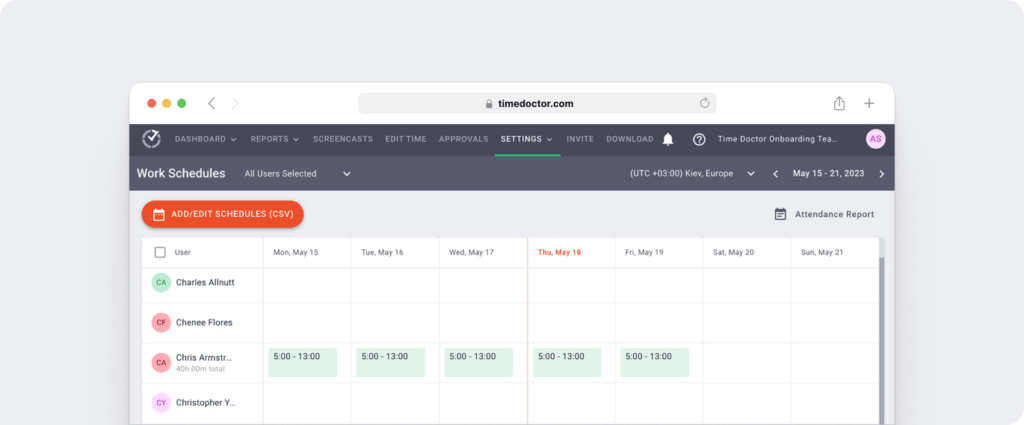
The platform has two time tracking modes. Teams can enable automatic time capture, which begins tracking time when employees log in to their work devices. With manual time tracking, team members can click to start and stop the tool.
When in tracking mode, Time Doctor can monitor activity on websites and in apps. Since the platform integrates with apps like Slack, Asana, Google Workspace, and Salesforce, it can reveal where your team spends the most time throughout the workday.
Time Doctor automatically keeps track of time spent on productive and unproductive sites and apps so you can ensure your team is using time wisely. It also takes screenshots so you can see what your team is working on in real time.
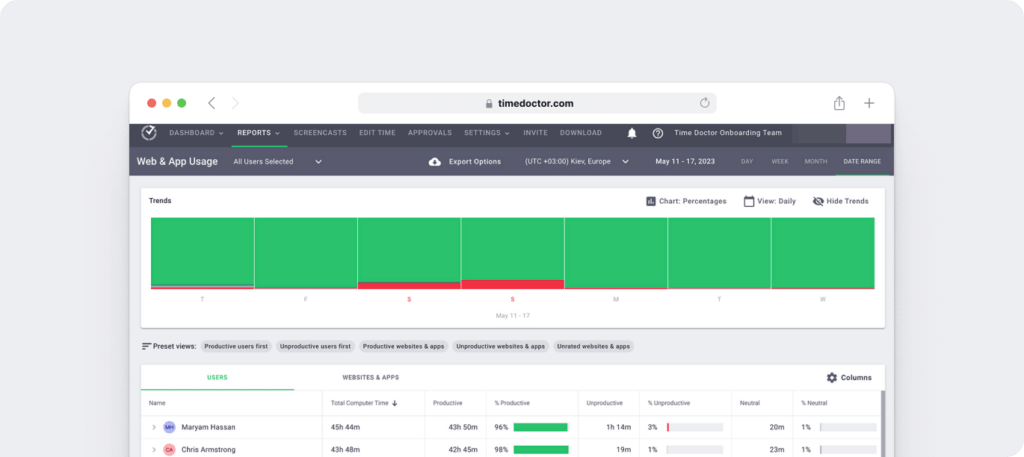
Although the platform doesn’t log keystrokes, it does monitor keyboard and mouse movement to detect active time. It automatically sends a notification to employees, nudging them to resume work if they’ve been idle for a preset amount of time.
At the same time, this employee-friendly tool gives users some control over the information they share. In addition to manual time tracking options, Time Doctor allows employees to blur sensitive information from screenshots.
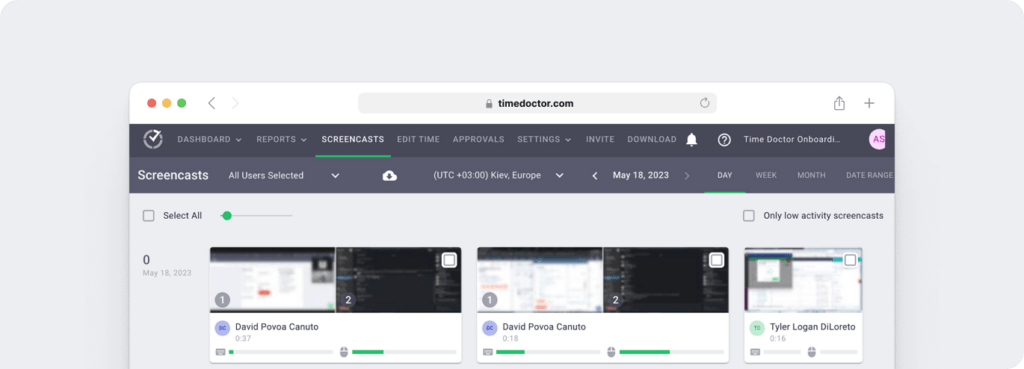
With Time Doctor’s robust reports, there’s no need to analyze your team’s data manually. These reports provide insights for individual employees, teams, and projects—including internet usage, attendance, and tasks.

In addition, the platform automatically highlights team members with potential work-life balance issues. With this data, you can take steps to improve workflows, rebalance tasks, and provide time off as necessary.
Time Doctor: Pros
- The 14-day free trial allows users to test the platform and experience the features firsthand.
- Choose between manual and automatic time capture to meet team and employee needs.
- The scheduling features provide a complete attendance tracking solution.
- Video screen recording gives premium users more options for monitoring remote teams.
- Distraction alerts keep team members on task and avoid unproductive or idle time.
- An intuitive interface helps admins assess productivity trends and issues at a glance.
- Reports highlight top performers and employees with work-life balance issues so admins can take action.
- Premade reports feature actionable insights.
- Custom reports allow admins to monitor the metrics they need.
- Client login capabilities allow organizations to provide added transparency and proof of work.
Time Doctor: Cons
- No free forever plan, but it has a limited-time free trial and a lower-priced paid plan.
- No shared kiosk where hybrid team members can clock in when working in person.
- Fewer app integrations, but it works with major project management and payroll apps.
What is TimeCamp?
Founded in 2008, TimeCamp is an employee time tracking app designed to monitor work hours, manage projects and tasks, and simplify billing and invoicing. The desktop and mobile apps (Android and iOS) and Chrome extension work well for remote and hybrid teams.
Over 18,000 remote and hybrid teams around the world use TimeCamp. With the help of this platform, customers have reached goals like saving 30+ hours per month on time-tracking tasks.
TimeCamp feature summary
TimeCamp claims it offers automatic time tracking, but that’s not entirely accurate. Users always have to start and stop the app’s tracking tools manually. However, TimeCamp can automatically add project or task labels to work hours if relevant keywords are set up in advance.
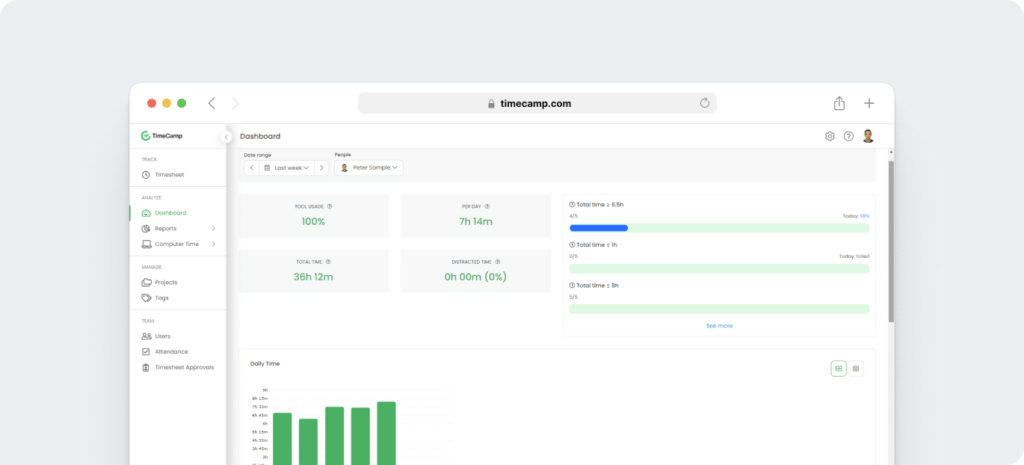
When your team starts tracking work hours, the platform can monitor website and app usage to keep an eye on productive versus unproductive time. It also separates idle and private time from work hours so you can bill clients accurately.
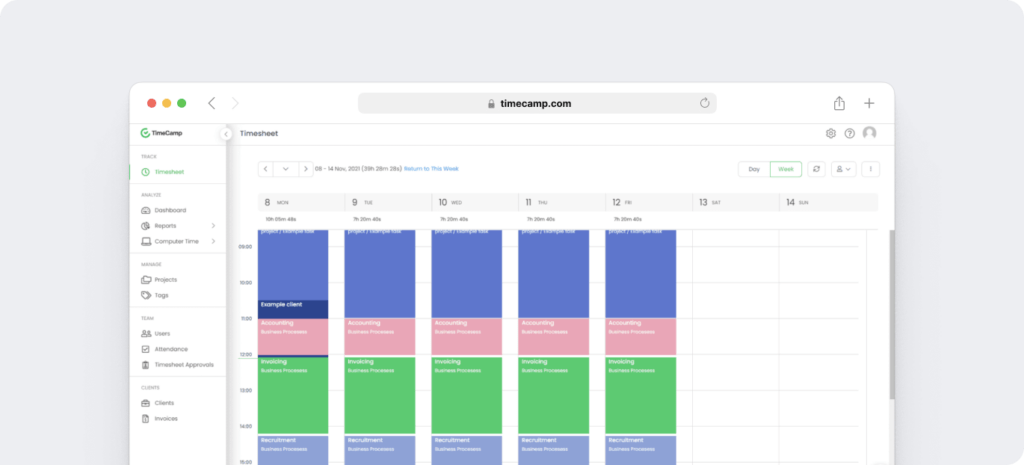
Whether you use TimeCamp’s web app, mobile app, or kiosk, the platform can eliminate paper time cards and provide a more reliable electronic solution. The app also lets admins approve time sheets for faster and easier payments.
Since the platform integrates with payroll tools like QuickBooks, TimeCamp can transform time entries into paychecks. You can also set billing rates in TimeCamp for easier contractor payments. This way, you can ensure your entire team gets paid efficiently.
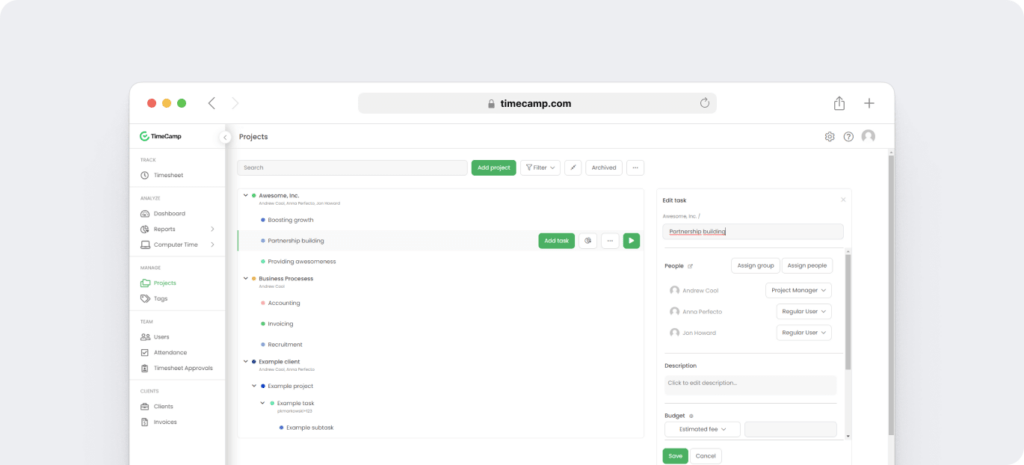
While TimeCamp has basic project management tools, it integrates with apps like Asana, Trello, and monday.com to help your team keep track of tasks and bill accurately for projects. It even integrates with CRM tools like Salesforce and HubSpot so you can monitor tasks more efficiently.
Although TimeCamp’s reports are less advanced overall, the platform does make it easy for admins to create simple ones. TimeCamp has preset reports for time frames and individual performance, including options to create custom reports.
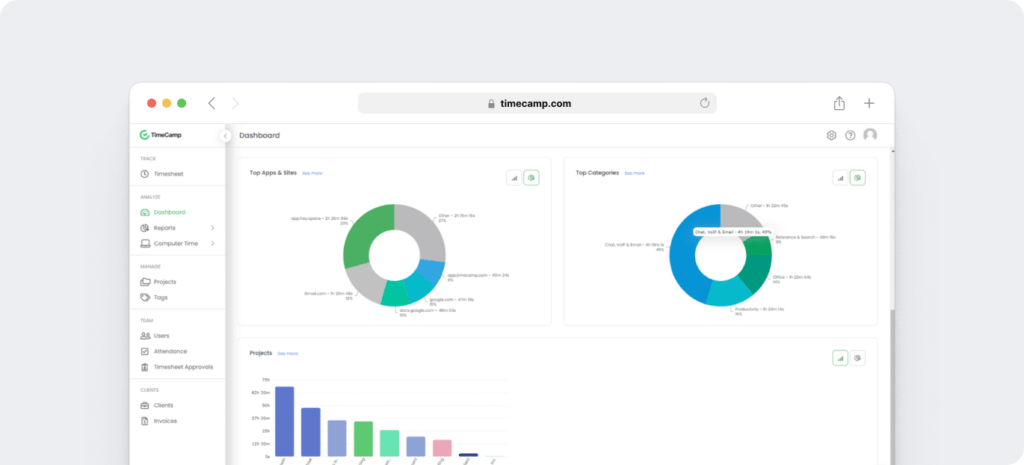
Team managers can also get real-time reports on team performance, making monitoring project timelines and budgets easier while the project is in progress. With TimeCamp’s report-sharing feature, admins can send these insights to clients or stakeholders as necessary.
TimeCamp: Pros
- The free forever plan allows bootstrapped teams to track time on a limited budget.
- The time clock kiosk lets hybrid teams clock in when working in the office.
- Project budgeting tools help reduce non-billable hours and monitor the actual work cost.
- Over 85 website and app integrations allow seamless time tracking and project management.
TimeCamp: Cons
- No fully automatic time capture; users have to click to begin monitoring work time.
- Limited preset report options require admins to invest time in building custom reports.
- Offers project management capabilities via a separate app rather than a fully integrated solution.
- Lacks scheduling tools or advanced employee attendance capabilities
- Higher price points at each paid subscription level, and doesn’t list enterprise pricing
Final thoughts on TimeCamp vs. Time Doctor
Time Doctor and TimeCamp are each full-featured time trackers that can help monitor employees, manage projects, and improve productivity. However, if you’re looking for a solution that scales and provides actionable insights, Time Doctor is a smarter solution.
Want to test out this time and project management software for your team? Sign up for a free trial of Time Doctor and start tracking your team’s time today.


